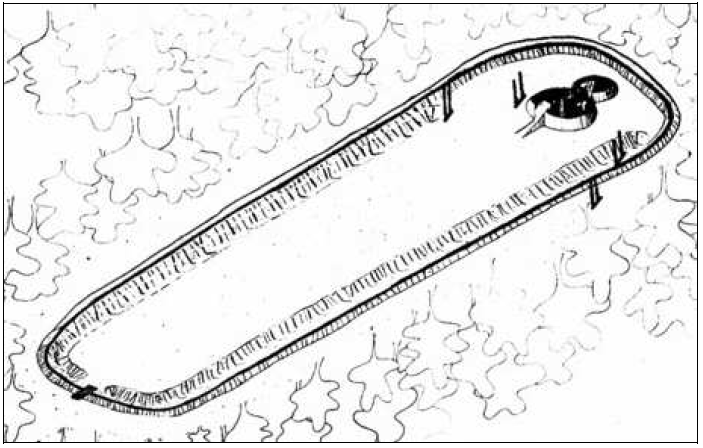Chapter 2
Nature and Bounty
Introduction
Irish mythology and Gallo-British archaeology are clearly evocative of a worship rendered to the Earth and Nature. The Irish legends illustrate the concept of an otherworld realm, called sídh, situated beneath the earth, the mountains or water.599 The Lebor Gabála Érenn [‘The Book of Invasions’] relates that the Tuatha Dé Danann, after being defeated by the mortal Son of Míl, retreated beneath the earth and dwelt in ancient cairns and tumulus*.600 From that time on, the world was divided in two: human beings inhabited the surface of the earth, while gods and goddesses lived in the Underworld. This explains why caves, hills, springs, lakes and rivers were regarded as entrances or doors towards the supernatural world. In Gaul and Britain, votive offering wells, generally excavated on religious centres, may be a reflection of such a concept.
Iron Age sanctuaries were generally surrounded by a ditch and enclosed by a fence, in the middle of which a pit or ‘hollow altar’ was dug. The pits could be a rectangular, circular, oval or indefinite shape. Their width could vary from 1 to 5 metres and their depth from 1 to 3 metres.601 Archaeological evidence reveals that those concave altars served for the deposit of food offerings, which were part of a whole complex of religious rites. The digging of a well was a concrete way to reach and make contact with the gods and goddesses, who were believed to dwell beneath the ground. Such sacred cavities are found in the 3rd/2nd-century BC sanctuary of Gournay-sur-Aronde (Oise), where entire bovids were left to decompose in nine pits situated in the heart of the enclosure, and in the polygonal enclosure of the 3rd c. BC sanctuary of Ribemont-sur-Ancre (Somme), which had a pit filled in with carcasses of domestic animals in its centre. The most significant example of this type is undoubtedly the 3rd c. BC open-air oval ditched enclosure of Libenice (Czech Republic), which covers a surface of 1600 m2 and has an impressive 2-metre deep subterranean edifice of 11x8 metres, composed of two oval rooms, in its south-east part (fig. 1).602 This sacrificial pit could be reached by means of a sort of banister or stairs flanked by two walls. The presence in the first cavity of bones of breeding and domestic animals, such as bulls, pigs, sheep, goats and dogs, points to a cult rendered to a pastoral, agrarian and chthonian* deity. Some parts of the sacrificed animals were roasted and eaten in the enclosure, while the non-comestible rest were deposited in the pit and left to rot so as to feed the deity, ensuring the fertility of the ground, and pay homage to her.603 An iron ploughshare, interred at the bottom of a votive post in the 4th-2nd c. BC ditched circular enclosure of Frilford, Berkshire (Oxfordshire, GB), may be also indicative of a fertility cult rendered to an earth deity.604
The offering wells of those Iron Age sanctuaries provide proof of a cult devoted to deities of fertility. Carcasses of animals were dedicated to them and left to decompose in the earth in gratitude of their presents. This rite was also a way of ensuring the future fertility of the land. As the Celts did not write, inscriptions identifying those deities of prosperity cannot be found. As a consequence, the deities invoked remain anonymous. With regard to the various mythologies of the world, it is clear that fertility is mainly achieved and watched over by female deities.605 The goddess is actually the archetype of prosperity. This can be explained by the fact that the land has been regarded as a divine mother who nurtures her people since time immemorial. The characters of the Matres and Matronae, widely evidenced in the epigraphy and iconography of Britain and the Continent, significantly illustrate the tradition of ‘Mother-Goddesses’ feeding and protecting the human race. The babies and horns of plenty they hold in their arms also evidence such a role. As demonstrated in Chapter 1, the cult of the Matres particularly flourished in Gallo-Roman times and probably replaced ancient Celtic goddesses of abundance in certain areas. What evidence is there in Irish medieval literature and Gallo-British archaeology of specific goddesses embodying the Earth and purveying fertility? Who were they? What were their functions and how were they honoured?
The first part of this chapter will be devoted to goddesses personifying the land and possessing agrarian features, such as Irish Ériu, Macha, Tailtiu – all of earlier Celtic derivation - and Gaulish Litavi and Nantosuelta. The second part will then analyze the literary, epigraphic, etymological and iconographical data proving the existence of goddesses purveying natural riches, such as Irish Mór Muman and Danu, and Gaulish Rosmerta, Cantismerta and Atesmerta. The third part will examine the essence of goddesses attached to specific natural elements, such as animals, trees or mountains – the rivers and springs will be studied in the following chapter. Existing theories concerning the existence or nature of some goddesses, such as Gaulish Arduinna, who is universally understood as a woodland boar goddess, or Irish Flidais, who is generally said to be a woodland deer goddess, will also be considered.
